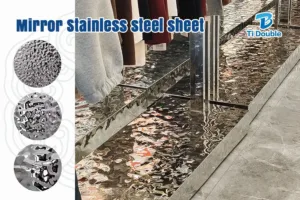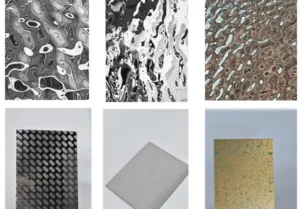Table of Contents
- I. The Production Process: From Raw Material to Finished Product
- II. Five Core Advantages of Brushed Finishes
- III. Industry Applications: Solving Real-World Challenges
- IV. Future Trends: Innovation in Stainless Steel Brushed Finish Technology
- Conclusion: Why Stainless Steel Brushed Finish Are Timeless
- FAQ: Stainless Steel Brushed Finish
In the realms of industrial design, architectural decoration, and premium consumer goods, the stainless steel brushed finish has endured as a timeless choice, celebrated for its unique texture and performance. Yet, few truly understand its manufacturing intricacies or why it outperforms alternatives. This article delves into the production process of brushed finishes and explores why they remain the top choice for designers, engineers, and consumers.


I. The Production Process: From Raw Material to Finished Product
Brushing is not mere “sanding” but a precision-driven process blending mechanical technology and aesthetic craftsmanship. Here’s a breakdown:
1. Base Material Selection
The foundation of a high-quality brushed finish lies in Grade 304 or 316 stainless steel, chosen for its high chromium-nickel content and superior corrosion resistance.
2. Surface Pretreatment
- Degreasing: Removes oils and contaminants to ensure uniform processing.
- Pickling & Passivation: Treats the surface with nitric or hydrofluoric acid to eliminate oxides and form a protective Cr₂O₃ passivation layer.
3. Mechanical Brushing
- Tools: Nylon abrasive belts, stainless steel brush rollers, or laser engravers.
- Brushing Techniques:
- Unidirectional Brushing: Creates uniform linear grains (common in elevator interiors and appliance panels).
- Cross Brushing: Produces intersecting textures for enhanced depth (used in decorative components).
- Random Brushing: Achieves a non-directional matte finish via sandblasting (ideal for custom designs).
- Grit Control: Lower grit numbers (e.g., 120 grit) yield deeper, coarser textures.
4. Post-Processing & Protection
- Cleaning: Removes metal debris to prevent contamination.
- Protective Coating (Optional): Transparent nano-coatings enhance fingerprint and scratch resistance.
II. Five Core Advantages of Brushed Finishes
1. Exceptional Wear Resistance
- Science: Micro-grooves distribute external forces, minimizing visible scratches.
- Data: Brushed surfaces achieve a Mohs hardness of 5.5–6.5, outperforming painted (3–4) or anodized aluminum (4–5).
2. Enhanced Corrosion Resistance
- Passivation Layer: The Cr₂O₃ layer and brushed texture jointly resist chemical erosion.
- Case Study: Coastal buildings using brushed stainless steel facades see 30% longer lifespans vs. polished surfaces.


3. Low Maintenance
- Fingerprint Resistance: Matte surfaces reduce cleaning frequency by 50% compared to mirror finishes.
- Cleaning Flexibility: Compatible with alcohol, neutral detergents, and industrial solvents.
4. Aesthetic & Functional Harmony
- Light Diffusion: Brushed textures eliminate glare, ideal for hospitals and labs.
- Ergonomic Grip: Surface roughness (Ra 0.4–1.6μm) improves grip in tools and medical devices.
5. Sustainability & Cost Efficiency
- Eco-Friendly: Zero VOC emissions, compliant with RoHS/REACH standards.
- Material Efficiency: 100% recyclable stainless steel with under 3% processing waste.
III. Industry Applications: Solving Real-World Challenges
Case 1: Smart Home Appliances
- Problem: Glossy refrigerators show fingerprints and wear.
- Solution: 240-grit unidirectional brushing + anti-stain coating reduced customer complaints by 72%.
Case 2: Rail Transit Interiors
- Problem: Handrails needing durability, antibacterial properties, and visual comfort.
- Solution: Cross-brushed 316 stainless steel with 20μm texture depth + copper-ion infusion achieved 99% antibacterial efficacy.
Case 3: Architectural Facades
- Problem: Glare from mirrored stainless steel violating light-pollution regulations.
- Solution: Random brushing cut reflectivity from 80% to 30%, securing LEED certification.
IV. Future Trends: Innovation in Stainless Steel Brushed Finish Technology
- Laser Brushing
- Precision: Fiber lasers engrave 0.01mm textures for custom patterns (e.g., hidden logos).
- Speed: 10m/min vs. traditional 2–3m/min.
- AI Quality Control
- Real-time monitoring with CCD cameras boosts yield to 99.9%.
- Hybrid Techniques
- Brushed + PVD Coating: Combines texture with rose gold or gunmetal hues (used in luxury watches).
Conclusion: Why Stainless Steel Brushed Finish Are Timeless
The allure of brushed stainless steel lies in its fusion of industrial precision and artistic expression. Each grain pattern reflects both functional rigor and aesthetic intent.
Whether for corrosion-resistant machinery or high-end consumer goods, the brushed finish delivers “quiet luxury” that meets the most demanding standards. Choosing this finish isn’t just a material decision—it’s a commitment to quality.
FAQ: Stainless Steel Brushed Finish
Q1: What’s the difference between brushed and polished stainless steel?
Brushed: Matte, non-reflective, linear texture; hides scratches.
Polished: Mirror-like shine; shows fingerprints and wear easily.
Q2: Why choose brushed over painted metal?
Durability: Resists chipping and UV fading.
Eco-Friendly: No toxic coatings or VOCs.
Q3: Does stainless steel brushed finish work outdoors?
Absolutely. Its corrosion resistance makes it ideal for façades, railings, and signage.
Q4: Can brushed stainless steel be colored?
Yes. PVD coating adds colors like gold, black, or bronze while preserving texture.



